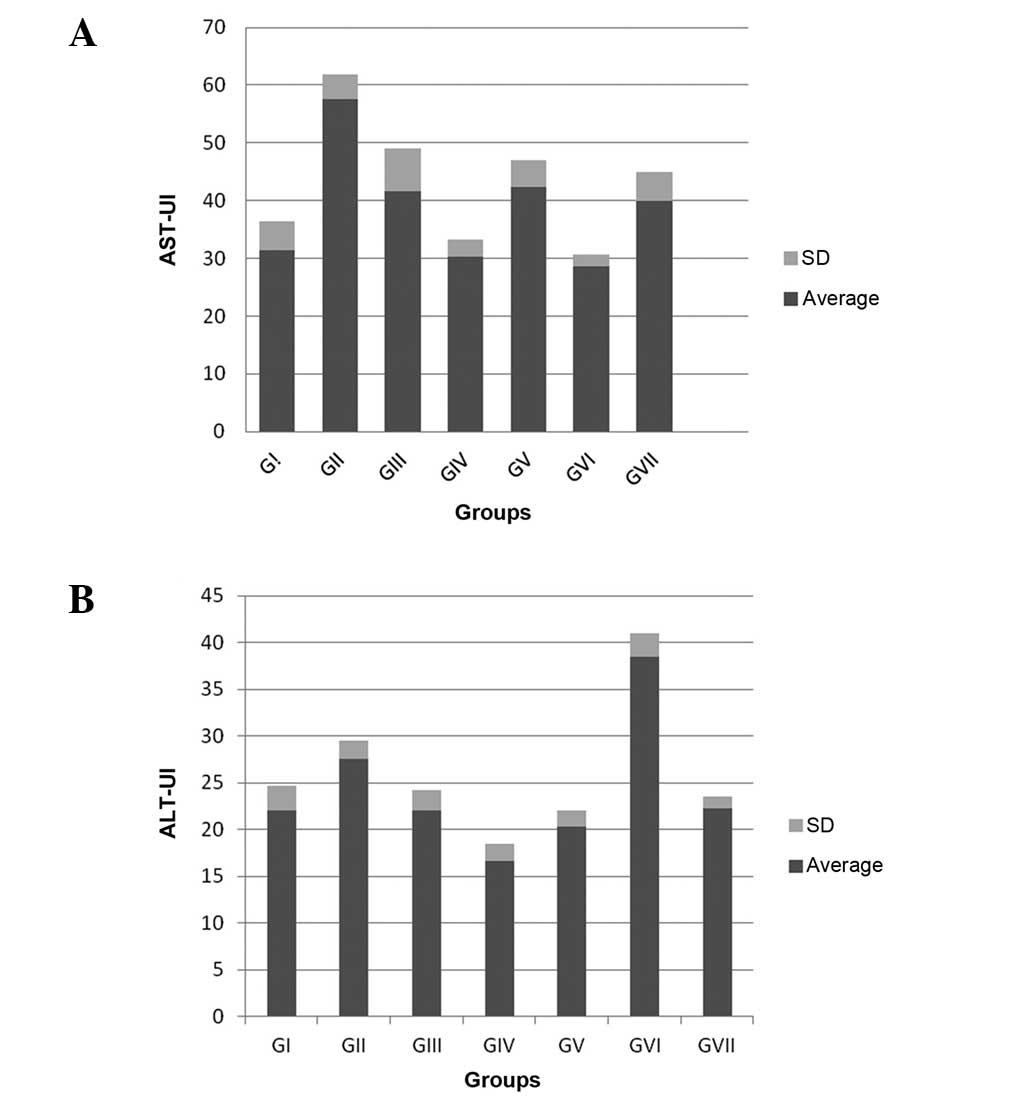|
1
|
Bataller R and Brenner DA: Liver fibrosis.
J Clin Invest. 115:209–218. 2005. View
Article : Google Scholar : PubMed/NCBI
|
|
2
|
Lotersztajn S, Julien B, Teixeira-Clerc F,
Grenard P and Mallat A: Hepatic fibrosis: molecular mechanisms and
drug targets. Annu Rev Pharmacol Toxicol. 45:605–628. 2005.
View Article : Google Scholar
|
|
3
|
Bissell DM: Hepatic fibrosis as wound
repair: a progress report. J Gastroenterol. 33:295–302. 1998.
View Article : Google Scholar : PubMed/NCBI
|
|
4
|
Kim HK, Yang TH and Cho HY: Antifibrotic
effects of green tea on in vitro and in vivo models of liver
fibrosis. World J Gastroenterol. 15:5200–5205. 2009. View Article : Google Scholar : PubMed/NCBI
|
|
5
|
Li CH, Piao DM, Xu WX, et al:
Morphological and serum hyaluronic acid, laminin and type IV
collagen changes in dimethylnitrosamine-induced hepatic fibrosis of
rats. World J Gastroenterol. 11:7620–7624. 2005.
|
|
6
|
Paz Z and Shoenfeld Y: Antifibrosis: to
reverse the irreversible. Clin Rev Allergy Immunol. 38:276–286.
2010. View Article : Google Scholar
|
|
7
|
Abdel-Majeed S, Mohammad A, Shaima AB,
Mohammad R and Mousa SA: Inhibition property of green tea extract
in relation to reserpine-induced ribosomal strips of rough
endoplasmic reticulum (rER) of the rat kidney proximal tubule
cells. J Toxicol Sci. 34:637–645. 2009. View Article : Google Scholar : PubMed/NCBI
|
|
8
|
Wang XH, Zhao J, Zhang WG, et al: Scanning
electron microscopic observation: three-dimensional architecture of
the collagen in hepatic fibrosis rats. Chin Med J (Engl).
120:308–312. 2007.
|
|
9
|
Al-Bloushi S, Safer AM, Afzal M and Mousa
SA: Green tea modulates reserpine toxicity in animal models. J
Toxicol Sci. 34:77–87. 2009. View Article : Google Scholar : PubMed/NCBI
|
|
10
|
Shimotoyodome A, Haramizu S, Inaba M,
Murase T and Tokimitsu I: Exercise and green tea extract stimulate
fat oxidation and prevent obesity in mice. Med Sci Sports Exerc.
37:1884–1892. 2005. View Article : Google Scholar : PubMed/NCBI
|
|
11
|
Yasuda Y, Shimizu M, Sakai H, et al:
(-)-Epigallocatechin gallate prevents carbon tetrachloride-induced
rat hepatic fibrosis by inhibiting the expression of the PDGFRbeta
and IGF-1R. Chem Biol Interact. 182:159–164. 2009. View Article : Google Scholar : PubMed/NCBI
|
|
12
|
Safer AM, Afzal M, Nomani A, Sosamma O and
Mousa SA: Curative propensity of green tea extract towards hepatic
fibrosis induced by CCl(4): A histopathological study. Exp Ther
Med. 3:781–786. 2012.PubMed/NCBI
|
|
13
|
Gressner AM: The cell biology of liver
fibrogenesis - an imbalance of proliferation, growth arrest and
apoptosis of myofibroblasts. Cell Tissue Res. 292:447–452. 1998.
View Article : Google Scholar : PubMed/NCBI
|
|
14
|
Mescher AL: Junquera’s Basic Histology:
Text and Atlas. 12th edition. McGraw Hill Medical; New York:
2010
|
|
15
|
Oh SW, Kim DH, Ha JR and Kim DY:
Anti-fibrotic effects of a methylenedioxybenzene compound, CW209292
on dimethylnitrosamine-induced hepatic fibrosis in rats. Biol Pharm
Bull. 32:1364–1370. 2009. View Article : Google Scholar : PubMed/NCBI
|
|
16
|
Sun H, Che QM, Zhao X and Pu XP:
Antifibrotic effects of chronic baicalein administration in a
CCl4 liver fibrosis model in rats. Eur J Pharmacol.
631:53–60. 2010. View Article : Google Scholar : PubMed/NCBI
|
|
17
|
Shirai N and Suzuki H: Effects of Western,
vegetarian, and Japanese dietary fat model diets with or without
green tea extract on the plasma lipids and glucose, and liver
lipids in mice. A long-term feeding experiment. Ann Nutr Metab.
48:95–102. 2004. View Article : Google Scholar : PubMed/NCBI
|
|
18
|
Augustyniak A, Waszkiewicz E and
Skrzydlewska E: Preventive action of green tea from changes in the
liver antioxidant abilities of different aged rats intoxicated with
ethanol. Nutrition. 21:925–932. 2005. View Article : Google Scholar : PubMed/NCBI
|
|
19
|
Chen JH, Tipoe GL, Liong EC, et al: Green
tea polyphenols prevent toxin-induced hepatotoxicity in mice by
down-regulating inducible nitric oxide-derived prooxidants. Am J
Clin Nutr. 80:742–751. 2004.PubMed/NCBI
|
|
20
|
Dobrzyńska I, Sniecińska A, Skrzydlewska E
and Figaszewski Z: Green tea modulation of the biochemical and
electric properties of rat liver cells that were affected by
ethanol and aging. Cell Mol Biol Lett. 9:709–721. 2004.
|
|
21
|
El-Beshbishy HA: Hepatoprotective effect
of green tea (Camellia sinensis) extract against tamoxifen-induced
liver injury in rats. J Biochem Mol Biol. 38:563–570. 2005.
View Article : Google Scholar : PubMed/NCBI
|
|
22
|
Erba D, Riso P, Bordoni A, et al:
Effectiveness of moderate green tea consumption on antioxidative
status and plasma lipid profile in humans. J Nutr Biochem.
16:144–149. 2005. View Article : Google Scholar : PubMed/NCBI
|
|
23
|
Mohamadin AM, El-Beshbishy HA and El-Mahdy
MA: Green tea extract attenuates cyclosporine A-induced oxidative
stress in rats. Pharmacol Res. 51:51–57. 2005. View Article : Google Scholar
|
|
24
|
Sadzuka Y, Inoue C, Hirooka S, et al:
Effects of theanine on alcohol metabolism and hepatic toxicity.
Biol Pharm Bull. 28:1702–1706. 2005. View Article : Google Scholar : PubMed/NCBI
|
|
25
|
Skrzydlewska E, Augustyniak A, Michalak K
and Farbiszewski R: Green tea supplementation in rats of different
ages mitigates ethanol-induced changes in brain antioxidant
abilities. Alcohol. 37:89–98. 2005. View Article : Google Scholar
|
|
26
|
Yamamoto M, Miyamoto S, Moon JH, et al:
Effect of dietary green tea catechin preparation on oxidative
stress parameters in large intestinal mucosa of rats. Biosci
Biotechnol Biochem. 70:286–289. 2006. View Article : Google Scholar : PubMed/NCBI
|















